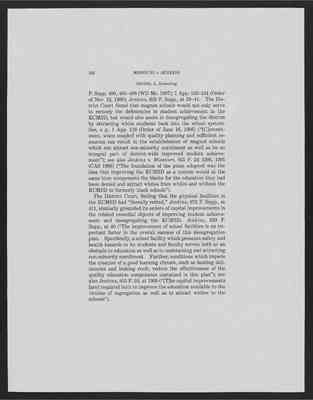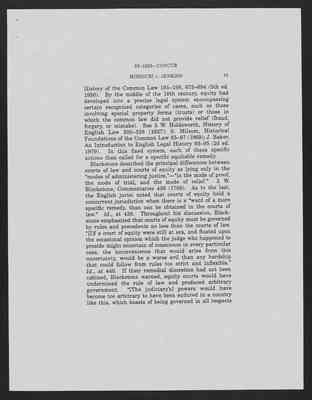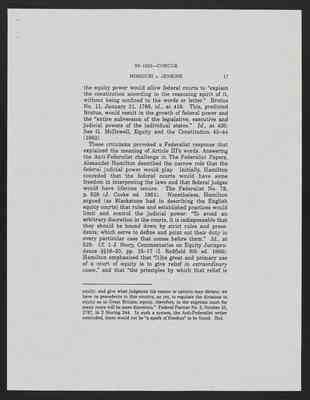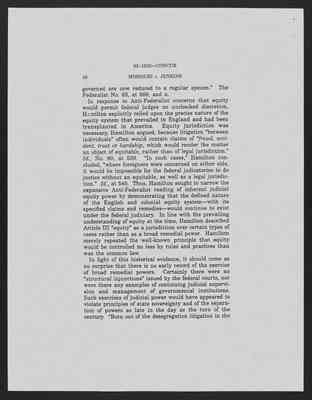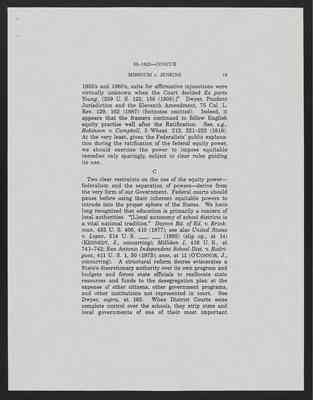Pages That Need Review
Missouri v Jenkins (70-176)
83
142 MISSOURI v. JENKINS
SOUTER, J., dissenting
F. Supp. 400, 405-408 (WD Mo. 1987); 1 App. 133-134 (Order of Nov. 12, 1986); Jenkins, 639 F. Supp., at 39-41. The District Court found that magnet schools would not only serve to remedy the deficiencies in student achievement in the KCMSD, but would also assist in desegregating the district by attracting white students back into the school system. See, e.g., 1 App. 118 (Order of June 16, 1986) ("[C]ommitment, when coupled with quality planning and sufficient resources can result in the establishment of magnet schools which can attract non-minority enrollment as well as be an integral part of district-wide improved student achievement"); see also Jenkins v. Missouri, 855 F. 2d 1295, 1301 (CA8 1988) ("The foundation of the plans adopted was the idea that improving the KCMSD as a system would at the same time compensate the blacks for the education they had been denied and attract whites from within and without the KCMSD to formerly black schools").
The district Court, finding that the physical facilities in the KCMSD had "literally rotted," Jenkins, 672 f. Supp., at 411, similarly grounded its orders of capital improvements in the related remedial objects of improving student achievement and desegregating the KCMSD. Jenkins, 639 F. Supp., at 40 ("The imprvement of school facilities is an important factor in the overall success of this desegregtion plan. specifically, a school facility which presents safety and health hazards to its students and faculty serves both as an obstacle to education as well as to maintaining and attracting non-minority enrollment. Further, conditions which impede the creation of a good learning cliate, such as heating deficiencies and leaking roofs, reduce the effectiveness of the quality eduction components contained in this plan"); see also Jenkins, 855 F. 2d, at 1305 ("[T]he capital improvements (are) required both to improve the education available to the victims of segregation as well as to attract whites to the schools").
84
Cite as: 515 U.S. 70 (1995) 143
SOUTER, J., dissenting
As a final element of its remedy, in 1987 the District Court ordered funding for increases in teachers' salaries as a step toward raising the level of student achivement. "(I)t is essential that the KCMSD have sufficient revenues to fund an operating budget which can provide quality education, including a high quality faculty." Jenkins, 672 F. Supp., at 410. neither the State nor the KCMSD objected to increases in teachers' salaries as an element of the comprehensive remedy, or to this cost as an item in the desegregation budget.
In 1988, however, the State went to the Eighth Circuit with a broad challenge to the District Court's remedial concept of magnet schools and to its orders of capital improvements (though it did not appeal the salary order), arguing that the District Court had run afoul of Milliken v. Bradley, 418 U.S. 717 (1974) (Milliken I), by ordering an interdistrict remedy for an intradistrict violation. The Eighth Circuit rejected the State's position, Jenkins, 855 F. 2d 1295, and in 1989 the State petitioned for certiorari.
The State's petition presented two questions for review, one challenging the District Court's authority to order a property tax increse to fund its remedial program, the other going to the legitimacy of the magnet school concept at the very foundation of the Court's desegregation plan:
"For a purely intradistrict violation, the courts below have ordered remedies-costing hundreds of millions of dollars-with the stated goals of attracting more nonminority students to the school district and making programs and facilities comparable to those in neighboring districts....
"The questio(n) presented (is).... "...Whether a federal court, remedying an intradistrict violation under Brown v. Board of Education, 347 U.S. 483 (1954), may
85
144 MISSOURI v. JENKINS
SOUTER, J., dissenting
"a) impose a duty to attract additional non-minority students to a school district, and "b) required improvements to make the district schools comparable to those in surrounding districts." Pet. for Cert. in Missouri v. Jenkins, O.T. 1988, No. 88-1150, p.i.
We accepted the taxation question, and decided that while the District Court could not impose the tax measure itself, it could require the district to tax property at a rate adequate to fund its share of the costs of the desegregation remedy. Missouri v. Jenkins, 495 U.S. 33, 50-58 (1990). If we had accepted the State's broader, foundational question going to the magnet school concept, we could also have made an informed decision on whether that element of the District Court's remedial scheme was within the limits of the Court's equitable discretion in response to the constitutional violation found. Each party would have briefed the question fully and would have identified in some detail those items in the record bearing on it. But none of these things happened. Instead of accepting the foundational question in 1989, we denied certiorari on it. Missouri v. Jenkins, 490 U.S. 1034.
The State did not raise that question again when it returned to this Court with its 1994 petition for certiorari, which led to today's decision. Instead, the State presented, and we agreed to review, these two questions:
"1. Whether a remedial educational desegregation program providing greater educational opportunities to victims of past de jure segregation than provided anywhere else in the country nonetheless fails to satisfy the Fourteenth Amendment (thus precluding a finding of partial unitary status) solely because student achievement in the District, as measured by results on standardized test scores, has not risen to some unspecified level?
"2. Whether a federal court order granting salary increases to virtually every employee of a school district -
Missouri v Jenkins 2 (NOTE)
63
93-1823-CONCUR
MISSOURI v. JENKINS 15
History of the Common Law 191-198, 673-694 (5th ed. 1956). By the middle of the 18th century, equity had developed into a precise legal system encompassing certain recognized categories of cases, such as those involving special property forms (trusts) or those in which the common law did not provide relief (fraud, forgery, or mistake). See 5 W. Holdsworth, History of English Law 300-338 (1927); S. Milsom, Historical Foundations of the Common Law 85-87 (1969); J. Baker, An Introduction to English Legal History 93-95 (2d ed. 1979). In this fixed system, each of these specific actions then called for a specific equitable remedy.
Blackstone described the principle differences between courts of law and courts of equity as lying only in the "modes of administering justice," - "in the mode of proof, the mode of trial, and the mode of relief." 3 W. Blackstone, Commentaries 436 (1768). As to the last, the English jurist noted that courts of equity held a concurrent jurisdiction when there is a "want of a more specific remedy, than can be obtained in the courts of law." Id., at 438. Throughout his discussion, Blackstone emphasized that courts of equity must be governed by rules and precedents no less than the courts of law. "(I)f a court of equity were still at sea, and floated upon the occasional opinion which the judge who happened to preside might entertain of conscience in every particular case, the inconvenience that would arise from this uncertainty, would be a worse evil than any hardship that could follow from rules too strict and inflexible." Id., at 440. If their remedial discretion had not been cabined, Blackstone warned, equity courts would have undermined the rule of law and produced arbitrary government. "(The judiciary's) powers would have become too arbitrary to have been endured in a country like this, which boasts of being governed in all respects.
64
93-1823-CONCUR
16 MISSOURI v. JENKINS
by law and not by will." Ibid. (footnote omitted); see also 1 id., at 61-62. 3
So cautioned, the Framers approached equity with suspicion. As Thomas Jefferson put it, "Relieve the judges from the rigour of text law, and permit them, with pretorian discretion, to wander into it's equity, and the whole legal system becomes incertain." 9 Papers of Thomas Jefferson 71 (J. Boyd ed. 1954). Suspicion of judicial discretion led to criticism of Article III during the ratification of the Constitution. Anti-Federalists attacked the Constitution's extension of the federal judicial power to "Cases, in Law and Equity," arising under the Constitution and federal statutes. According to the Anti-Federalists, the reference to equity granted federal judges excessive discretion to deviate from the requirements of the law. Said the "Federal Farmer," "by thus joining the word equity with the word law, if we mean any thing, we seem to mean to give the judge a discretionary power." Federal Farmer No. 15, January 18, 1788, in 2 The Complete Anti-Federalist 322 (H. Storing ed. 1981) (hereinafter Storing). He hoped that the Constitution's mention of equity jurisdiction was not "intended to lodge an arbitrary power or discretion in the judges, to decide as their conscience, their opinions, their caprice, or their politics might dictate." Id., at 322-323.4 Another Anti-Federalist, Brutus, argued that
[Footnotes] 3 As Blackstone wrote: "(A) set of great and eminent lawyers . . . have by degrees erected the system of relief administered by a court of equity into a regular science, which cannot be attained without study and experience, any more than the science of law: but from which, when understood, it may be known what remedy a suitor is entitled to expect, and by what mode of suit, as readily and with as much precision, in a court of equity as in a court of law." 3 Blackstone, at 440-441
4 The Federal Farmer particularly feared the combination of equity and law in the same federal courts: "It is a very dangerous thing to vest in the same judge power to decide on the law, and also general powers in equity; for if the law restrain him, he is only to step into his shoes of
65
93-1823-CONCUR
MISSOURI v. JENKINS 17
the equity power would allow federal courts to "explain the constitution according to the reasoning spirit of it, without being confined to the words or letter." Brutus No. 11, January 31, 1788, id., at 419. This, predicated Brutus, would result in the growth of federal power and the "entire subversion of the legislative, executive and judicial powers of the individual states." Id., at 420. See G. McDowell, Equity and the Constitution 43-44 (1982).
These criticisms provoked a Federalist response that explained the meaning of Article III's words. Answering the Anti-Federalist challenge in The Federalist Papers, Alexander Hamilton described thenarrow role that the federal judicial power would play. Initially, Hamilton conceded that the federal courts would have some freedom in interpreting the laws and that federal judges would have lifetime tenure. The Federalist No. 78, p. 528 (J. Cooke ed. 1961). Nonetheless, Hamilton argued (as Blackstone had in describing the English equity courts) that rules and established practices would limit and control the judicial power: "To avoid an arbitrary discretion in the courts, it is indespensable that they should be bound down by strict rules and precedents, which serve to define and point out their duty in every particular case that comes before them." Id., at 529. Cf. 1 J. Story, Commentaries on Equity Jurisprudence [??]18-20, pp. 15-17 (I. Redfield 9th ed. 1866). Hamilton emphasized that "(t)he great and primary use of a court of equity is to give relief in extraordinary cases," and that "the principles by which that relief is
{Footnotes} equity, and give what judgement his reason or opinion may dictate; we have no precedents in this country, as yet, to regulate the divisions in equity as in Great Britain; equity, therefore, in the supreme court for many years will be mere discretion." Federal Farmer No. 3, October 10, 1787, in 2 Storing 244. In such a system, the Anti-Federalist writer concluded, there would not be "a spark of freedom" to be found. Ibid.
66
93-1823-CONCUR
18 MISSOURI v. JENKINS
governed are now reduced to a regular system." The Federalist No. 83, at 569, and n.
In reponse to Anti-Federalist concerns that equity would permit federal judges an unchecked discretion, Hamilton explicitly relied upon the precise nature of the equity system that prevailed in England and had been transplanted in America. Equity jurisdiction was necessary, Hamilton argued, because litigation "between individuals" often would contain claims of "fraud, accident, trust or hardship, which would render the matter an object of equitable, rather than of legal jurisdiction." Id., No. 80, at 539. "In such cases," Hamilton concluded, "where foreigners were concerned on either side, it would be impossible for the federal judicatories to do justice without an equitable, as well as a legal jurisdiction." Id., at 540. Thus, Hamilton sought to narrow the expansive Anti-Federalist reading of inherent judicial equity power by demonstrating that the defined nature of the English and colonial equity system - with its specified claims and remedies - would continue to exist under the federal judiciary. In line with the prevailing understanding of equity at the time, Hamilton described Article III "equity" as a jurisdiction over certain types of cases rather than as a broad remedial power. Hamilton merely repeated the well-known principle that equity would be controlled no less by rules and practices than was the common law.
In light of this historical evidence, it should come as no surprise that there is no early record of the exercise of broad remedial powers. Certainly there were no "structural injunctions" issued by the federal courts, nor were there any examples of continuing judicial supervision and management of governmental institutions. Such exercises of judicial power would have appeared to violate principles of state sovereignty and of the separation of powers as late in the day as the turn of the century. "Born out of the desegregation litigation in the
67
93-1823-CONCUR
MISSOURI v. JENKINS 19
1950's and 1960's, suits for affirmative injunctions were virtually unknown where the Court decided Ex parte Young, (209 U. S. 123, 158 (1908).)" Dwyer, Pendent Jurisdiction and the Eleventh Amendment, 75 Cal. L. Rev. 129, 162 (1987) (footnotes omitted). Indeed, it appears that the framers continued to follow English equity practice well after the Ratification. See, e.g., Robinson v. Campbell, 3 Wheat, 212, 221-223 (1818). At the very least, given the Federalists' public explanation during the ratification of the federal equity power, we should exercise the power to impose equitable remedies only aparingly, subject to clear rules guiding its use.
C
Two clear restraints on the use of the equity power - federalism and the separation of powers - derive from the very form of the Government. Federal courts should pause before using their inherent equitable powers to intrude into the proper sphere of the States. We have long recognized that education is primarily a concern of local authorities. "(L)ocal autonomy of school districts is a vital national tradition." Dayton Bd. of Ed. v. Brinkman, 433 U. S. 406, 410 (1977); See also United States v. Lopez, 514 U. S. __, __ (1995) (slip op., at 14) (KENNEDY, J., concurring); Milliken I, 418 U. S., at 741-742; San Antonio Independent School Dist. v. Rodriguez, 411 U. S. 1, 50 (1973); ante, at 11 (O'CONNOR, J., concurring). A structural reform decree eviscerates a State's discretionary authority over its own program and budgets and forces state officials to reallocate state resources and funds to the desegregation plan at the expense of other citizens, other government programs, and other institutions not represented in court. See Dwyer, supra, at 163. When district Courts seize complete control over the schools, they strip state and local governments of one of their most important
74
93-1823—CONCUR
26 MISSOURI v. JENKINS
state and local governments to work toward the benefit of those who have suffered no harm from their actions.
To ensure that district courts do not embark on such broad initiatives in the future, we should demand that remedial decrees be more precisely designed to benefit only those who have been victims of segregation. Raceconscious remedies for discrimination not only must serve a compelling governmental interest (which is met in desegregation cases), but also must be narrowly tailored to further that interest. See Richmond v. J. A. Croson Co., 488 U. S. 469, 509-510 (1989) (plurality opinion). In the absence of special circumstances, the remedy for de jure segregation ordinarily should not include educational programs for students who were not in school (or were even alive) during the period of segregation. Although I do not doubt that all KCMSD students benefit from many of the initiatives ordered by the court below, it is for the democratically accountable state and local officials to decide whether they are to be made available even to those who were never harmed by segregation.
III
This Court should never approve a State's efforts to deny students, because of their race, an equal opportunity for an education. But the federal courts also should avoid using racial equality as a pretext for solving social problems that do not violate the Constitution. It seems apparent to me that the District Court undertook the worthy task of providing a quality education to the children of KCMSD. As far as I can tell, however, the District Court sought to bring new funds and facilities into the KCMSD by finding a constitutional violation on the part of the State where there was none. Federal courts should not lightly assume that States have caused "racial isolation" in 1984 by maintaining a segregated school system in 1954. We must forever put aside the
76
SUPREME COURT OF THE UNITED STATES
No. 93-1823
MISSOURI, ET AL., PETITIONERS v. KALIMA JENKINS ET AL..
ON WRITE OF CERTIORARI TO THE UNITED STATES COURT OF APPEALS FOR THE EIGHTH CIRCUIT
(June 12, 1995)
JUSTICE SOUTER, with whom JUSTICE STEVENS, JUSTICE GINSBURG, and JUSTICE BREYER join, dissenting.
The Court's process of orderly adjudiction has broken down in this case. The Court disposes of challenges to only two of the District Court's many discrete remedial orders by declaring that the District Court erroneously provided an interdistrict remedy for an intradistrict violation. In doing so, it resolves a foundational issue going to one element of the District Court's decree that we did not accept for review in this case, that we need not reach in order to answer the questions that we did accept for review, and that we specifically refused to consider when it was presented in a prior petition for certiorari. Since, under these circumstances, the respondent school district and pupils naturally came to this Court without expecting that a fundamental premise of a portion of the District Court's remedial order would become the focus of the case, the essence of the Court's misjudgement in reviewing and repudiating that central premise lies in its failure to have warned the respondents of what was really at stake. This failure lulled the respondents into addressing the case without sufficient attention to the foundational issue, and their lack of attention has now infected the Court's decision.
No one on the Court has had the benefit of briefing.
